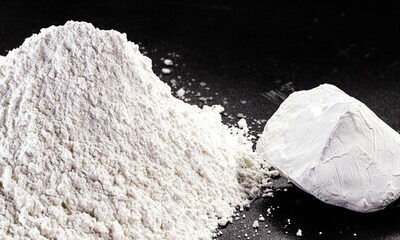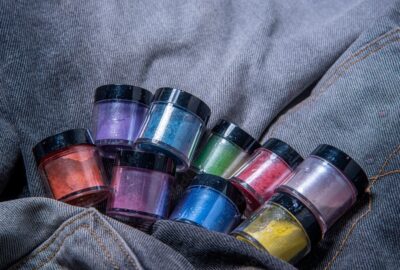Kaolin Clay
- Kaolin (china clay) is a hydrated alumina silicate (Al2O3.2SiO2.2H2O) crystalline mineral (kaolinite), formed by the decomposition of minerals such as Granite & Feldspar. The name kaolin derives from the Chinese and means high ridge.
- Kaolin, also known as china clay is a soft, white clay mineral primarily composed of kaolinite. It is used extensively in various industries due to its desirable properties, such as whiteness, absorbency, and fine particle size.
- Kaolin, or china clay, has specific properties and specifications that vary depending on its intended use.
Formation of Kaolin:
1. Primary Kaolin (Residual Kaolin):
- Forms directly from the weathering of parent rocks, such as granite and remains at the site of its formation.
- Typically purer and contains fewer impurities.
- High-quality ceramics, porcelain, and specialized applications.
2. Secondary Kaolin (Sedimentary Kaolin):
- Transported from the original weathering site by water or wind and deposited elsewhere.
- May contain more impurities and be less pure than primary Kaolin.
- Common in paper coating, ceramics, and fillers.
Application of Kaolin:
- Ceramics body, Refractory & Insulation
- Printing Ink
- White Cement, Gray Cement etc.
- Detergent & Soap
- Rubber, Plastic and cable
- Sanitary ware
Physical Properties of Kaolin
- Color: Typically white, but may have slight variations due to impurities. White to off-white, with brightness typically above 80% (ISO brightness).
- Texture: Fine and smooth, with a silky feel.
- Chemical Composition: Primarily composed of kaolinite (Al2Si2O5(OH)4), often with traces of other minerals such as quartz, mica, and feldspar.
- Particle Size: Typically fine, with a high surface area. Particle sizes typically ranging from 1 to 2 microns.
- Plasticity: Exhibits good plasticity when wet, making it moldable. High plasticity when wet, which is important for molding and shaping.
- Moisture Content: Usually 10-15% in raw form.
- PH: Typically around 4.5-6.5 in a water suspension.
- Bulk Density: Approximately 2.5-2.7 g/cm3.
- Specific Gravity: Around 2.6-2.7 g/cm3.
| S.No | List of Parameters | Result in (%) | |
|---|---|---|---|
| 1 | Silica | Si2O3 | 49 |
| 2 | Iron Oxide | Fe2O3 | 0.5 |
| 3 | Alumina Oxide | Al2O3 | 37 |
| 4 | Sodium | Na2O | 0.151 |
| 5 | Magnesium Oxide | MgO | 0.055 |
| 6 | Titanium | TiO2 | 0.872 |
| 7 | Potassium | K2O | 0.054 |
| 8 | Calcium Oxide | CaO | 0.164 |
| 9 | Loss on Ignition | LOI | 12.21 |
Types of Kaolin Clay:
1. Raw Kaolin:
- Raw kaolin, or crude kaolin, is the natural form of kaolin directly extracted from the earth without any processing.
- Typically grayish to white, with a coarse texture.
- Requires further processing to remove impurities and enhance properties for specific uses.
- Can be used as is in some applications or as the starting material for more refined products.
2. Hydrous Kaolin (Hydrated Kaolin):
- Hydrous kaolin is kaolin that contains water of hydration, meaning it has not been subjected to high temperatures during processing.
- White and powdery with a fine texture.
- Produced by refining raw kaolin through processes like blunging (mixing with water), hydrocycloning (separating), and refining. It retains chemically bound water.
- Commonly used in paper coatings, ceramics, and fillers due to its plasticity and smoothness.
3. Calcined Kaolin:
- Calcined kaolin is kaolin that has been heated to high temperatures (above 600°C) in a kiln. This process removes water of hydration and changes the mineral structure.
- Typically white and fine, with altered physical properties compared to hydrous kaolin.
- The raw kaolin is calcined to enhance properties such as brightness, hardness, and thermal stability.
- Suitable for high-temperature applications, ceramics, paint formulations, and as an additive in plastics due to its improved hardness and thermal resistance.
4. Met kaolin:
- Metakaolin is a product of the calcination of kaolin at higher temperatures (between 600°C and 800°C). It is an anhydrous, amorphous form of kaolin.
- Fine, white, and powdery with a high surface area.
- Produced by heating kaolin to a temperature that dehydrates and partially dehydrates it, converting it into a reactive form.
- Primarily used as a pozzolanic material in concrete and cement applications, where it reacts with lime to form compounds that contribute to the strength and durability of the concrete.
Application of Kaolin Industrial & Others
1. Paper Grade Kaolin
- High brightness and fine particle size, used as a filler and coating agent in paper production.
- Improves the smoothness and printability of paper products.
2. Ceramic Grade Kaolin
- High purity and plasticity, suitable for making ceramics and porcelain.
- Used in the production of tiles, dinnerware, and sanitary ware.
3. Refractory Grade Kaolin
- High resistance to high temperatures, used in refractory materials.
- Essential in the manufacture of refractory bricks and other materials that withstand high temperatures.
4. Pharmaceutical and Cosmetic Grade Kaolin
- Pure and non-toxic, used in medical and cosmetic applications.
- Used in medications (e.g., antacids) and cosmetics (e.g., face masks).
5. Industrial Grade Kaolin
- Lower purity, used in a variety of industrial applications.
- Includes use in rubber, plastics, and as a filler in various products.
Reference Images:
Product Application:
Packing Available




















